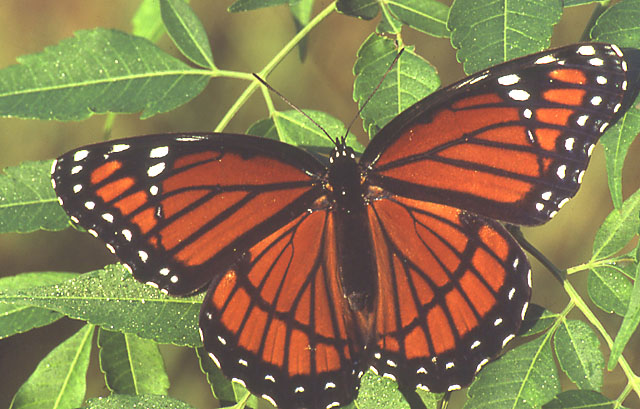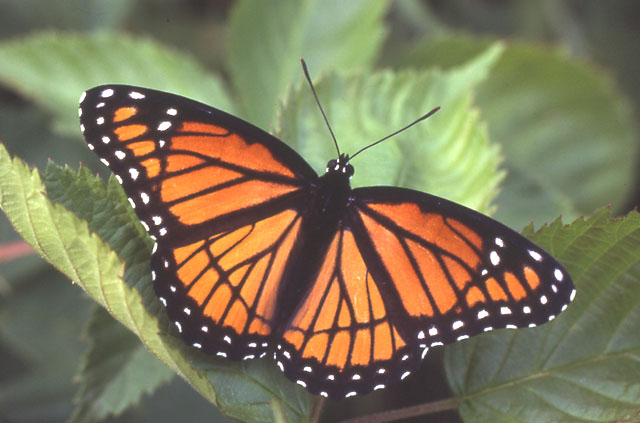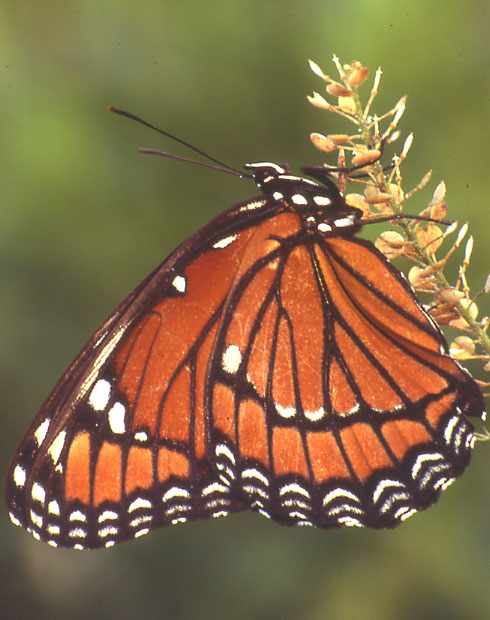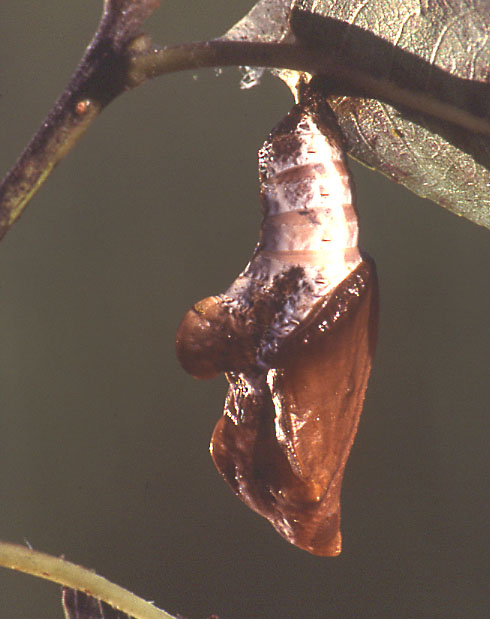Limenitis archippus
(Cramer, [1775]) (Papilio)

Limenitis archippus, Florida, courtesy of Leroy Simon.
Superfamily: Papilionoidea Latreille, [1802]
Family: Nymphalidae, Rafinesque, 1815, or
Family: Nymphalidae Swainson, 1827
Subfamily: Limenitidinae
Tribe: Limenitidini
Subtribe: Limenitidina
Genus: Limenitis Fabricius, 1807
|
Website designed and maintained
by Bill Oehlke
Box 476, Montague
Prince Edward Island, Canada C0A 1R0
oehlkew@islandtelecom.com
|
Distribution:
The Viceroy, Limenitis archippus
(wingspan: 2 1/2 - 3 3/8 inches (6.3 - 8.6 cm)),
flies in moist open or shrubby areas such as lake and swamp edges,
willow thickets, valley bottoms, wet meadows and roadsides
from the Northwest Territories south along the eastern edges of the
Cascade and Sierra Nevada mountains to central Mexico, east through
all the eastern United States and southern Canada.
The Obsolete Viceroy (subspecies obsoleta) has lost much of
its habitat due to development, water impoundment and the exotic
aggressive saltcedar.
Limenitis archippus idaho Austin, the Northwestern Viceroy or
Idaho Viceroy, flies in riparian habitat in Oregon and Idaho and other ares
of northwestern North America.
Description:
The upperside is orange and black,
resembling the Monarch (Danaus plexippus), except the Viceroy
has a black line across the hindwing and a single row of white dots
in the black marginal band. Where Monarchs are rare in Florida,
Georgia and the Southwest, Viceroys are brown instead of orange and
mimic the Queen (Danaus gilippus).

Limenitis archippus, Ohio, courtesy of Leroy Simon.

Limenitis archippus, Florida, courtesy of Leroy Simon.
Flight time(s) and Adult Food Sources:
There are two to three broods from May-September in most of its
range. it flies all year in Florida, but there is only a single brood in much of Canada.
Early in the season when few flowers are available, Viceroys feed on
aphid honeydew, carrion, dung and decaying fungi.
Later generations feed more often at flowers, favoring
composites including aster, goldenrod, joe-pye weed, shepherd's
needle and Canada thistle.
Eggs, Larvae, Pupae:
During most of the day, males perch on vegetation or patrol around
the host plants to find females. Females lay eggs at the tip of host
plant leaves, depositing only two or three eggs on a plant before
moving to another. Caterpillars eat their eggshells after they
hatch, then at night feed on catkins and leaves.
Young caterpillars make a ball of leaf bits, dung, and silk which
hangs off the leaf on which they are feeding. The dangling mass may
distract predators. Third-stage caterpillars make a shelter from a
rolled leaf tip in which to spend the winter.
Larvae feed on foliage of trees in the willow family (Salicaceae)
including willows (Salix), and poplars and cottonwoods
(Populus).

Limenitis archippus, hibernaculum (overwintering stage), Florida, courtesy of Leroy Simon.

Limenitis archippus, Florida, courtesy of Leroy Simon.
Larvae affix their anal claspers to a suitable
structure via a strong silk pad and then hang in a j-shape and shed their
skins one last time to form the chrysalis or pupa.
Adult butterflies emerge nine to fourteen days later.

Limenitis archippus, Florida, courtesy of Leroy Simon.
Use your browser "BACK" button to return to the previous page.
GO TO:
|
Monarch
Viceroy
White admiral
Mourning cloak
Milbert's tortoise shell
Black swallowtail
Canadian Tiger swallowtail
Cabbage white
Question mark
Satyr comma
Red admiral
Painted lady
American painted lady
|
Here are some additonal northeastern North American butterflies of interest.
To my knowledge, these species do not fly on Prince Edward Island, but I have reared
most of them as a boy growing up in rural New Jersey.
|
Pipevine swallowtail
Buckeye
Red-spotted purple
Giant swallowtail
Eastern Tiger swallowtail
Spicebush swallowtail
|
Use your browser "back" button to return to previous page.
Visit other websites maintained by Bill Oehlke:
+++LIVESTOCK AND SUPPLIES FOR SALE***
This site is designed and
maintained
by Bill Oehlke. You can reach Bill for questions
by clicking on his name (email) or by phone 902-838-3455,
or at Bill Oehlke,
Box 476, Montague, P.E.I., Canada C0A 1R0.
I offer two membership sites that far exceed the
coverage offered
on the sites listed above:
THE WORLD'S LARGEST SATURNIIDAE SITE and
CATERPILLARS TOO! North American (Canada/US) Butterfly website

Please click on the flashing butterfly icon to the right
to show
appreciation for this site and to visit other insect sites. Thankyou!
|
 |






